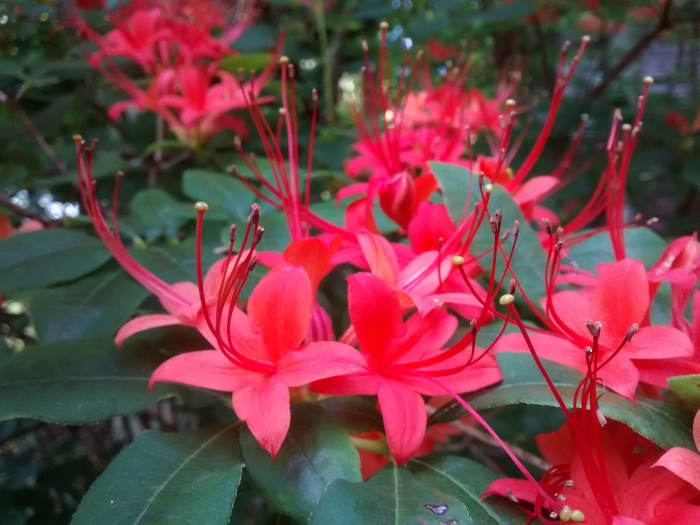Plumleaf Azalea
(Rhododendron prunifolium)
Plumleaf Azalea (Rhododendron prunifolium)
/
/

Allen C. Haskell Public Gardens
Public Domain Mark 1.0
Image By:
Allen C. Haskell Public Gardens
Recorded By:
Copyright:
Public Domain Mark 1.0
Copyright Notice:
Photo by: Allen C. Haskell Public Gardens | License Type: Public Domain Mark 1.0 | License URL: https://creativecommons.org/licenses/by-sa/2.0/ | Uploader: 2015 Plant Records Photos | Publisher: Flickr |





















Estimated Native Range
Summary
Rhododendron prunifolium, commonly known as Plumleaf Azalea, is a deciduous shrub native to the moist, acidic soils of the woodland slopes and stream banks in the southeastern United States, specifically in Georgia and Alabama. It typically grows to a height of 9-12 feet (2.7-3.7 meters) and a width of 4-6 feet (1.2-1.8 meters). The Plumleaf Azalea is notable for its large, showy flowers that bloom in late summer, which is later than most azaleas. The flowers come in a range of warm hues including orange, pink, red, and white, and they attract pollinators such as butterflies and hummingbirds.
This species is valued for its vibrant late-season blooms and is used in woodland gardens, mixed borders, and as a specimen plant. It thrives in part shade, though it can tolerate full sun in cooler climates, provided it has sufficient moisture. The Plumleaf Azalea requires acidic, well-drained soil and benefits from a layer of mulch to maintain soil moisture and temperature. It is relatively low maintenance but should be monitored for common azalea pests and diseases such as lace bugs and root rot. Due to its rarity in the wild, it is a special addition to any garden, offering a unique aesthetic appeal with its late flowering season.CC BY-SA 4.0
This species is valued for its vibrant late-season blooms and is used in woodland gardens, mixed borders, and as a specimen plant. It thrives in part shade, though it can tolerate full sun in cooler climates, provided it has sufficient moisture. The Plumleaf Azalea requires acidic, well-drained soil and benefits from a layer of mulch to maintain soil moisture and temperature. It is relatively low maintenance but should be monitored for common azalea pests and diseases such as lace bugs and root rot. Due to its rarity in the wild, it is a special addition to any garden, offering a unique aesthetic appeal with its late flowering season.CC BY-SA 4.0
Plant Description
- Plant Type: Shrub
- Height: 9-12 feet
- Width: 4-6 feet
- Growth Rate: Moderate
- Flower Color: Red
- Flowering Season: Spring, Summer
- Leaf Retention: Deciduous
Growth Requirements
- Sun: Full Sun, Part Shade
- Water: Medium
- Drainage: Fast
Common Uses
Bee Garden, Bird Garden, Butterfly Garden, Hummingbird Garden, Low Maintenance, Rabbit Resistant, Showy Flowers
Natural Habitat
Moist, acidic soils of woodland slopes and stream banks in southeastern United States
Other Names
Common Names: Plum-Leaf Azalea
Scientific Names: , Rhododendron prunifolium, Azalea prunifolia,
GBIF Accepted Name: Rhododendron prunifolium (Small) Millais